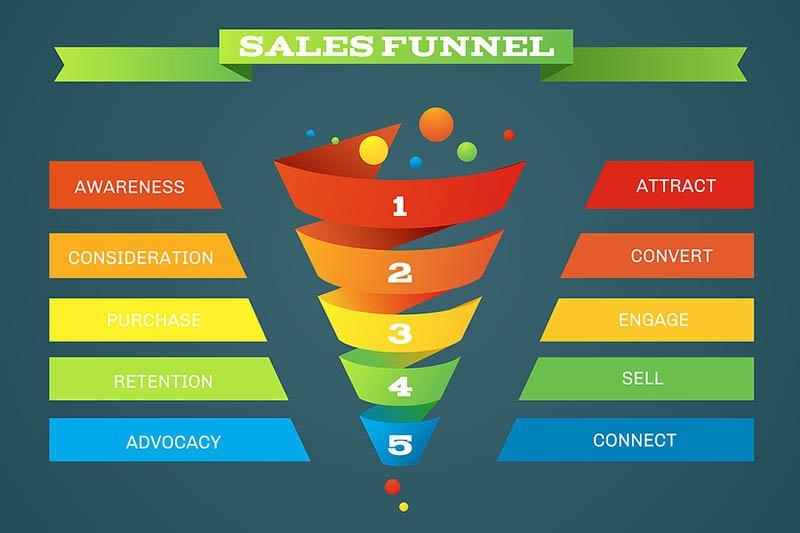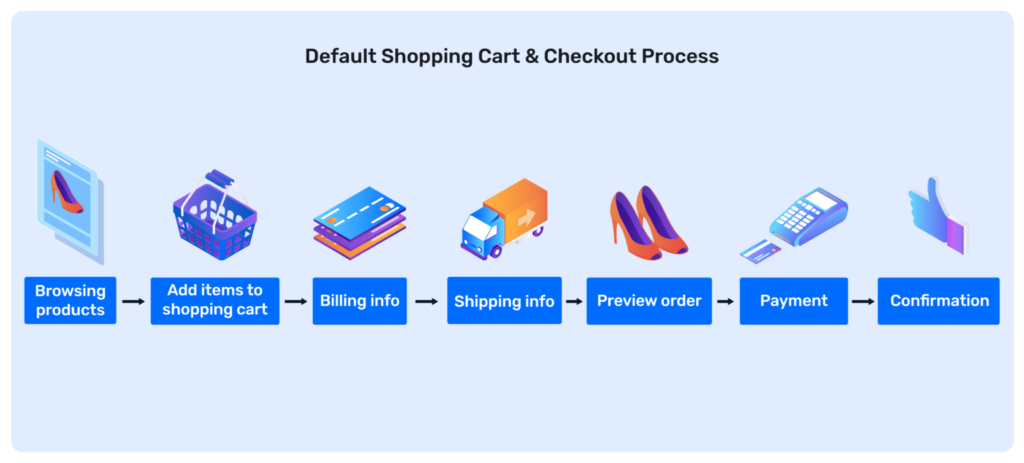The bottom of the sales funnel is where you want your customers to be. You’ve done most of the heavy lifting – getting them from the widest scope of opportunity and leading them down through the funnel to become interested enough to potentially purchase your products.
You have created connection, overcome obstacles, and passed the persistence test. But it’s still not the time to rest on your laurels.
In ecommerce, you can run the risk of losing the sale right up to the final moment. The average conversion rate for ecommerce sites is 2.63%. That’s a statistic that might make you flinch, but for ecommerce companies that have driven their customers to the bottom of the sales funnel, that’s a great achievement.
The key now is to not lose that sale. This is where optimizing the checkout process can help.
What is the bottom of the funnel conversion?
There are five stages of the funnel conversion process. These are awareness, consideration, decision, purchase, and retention. The bottom end of the funnel is where you’ll find the purchase and retention phases.
Your customer knows who you are, they are engaged, and they have made the decision to buy. All that’s left is the execution. At this point your potential customer should start to work through the purchase, and ecommerce brands really need to make this a frictionless experience to avoid the pitfalls of abandoned carts and high bounce rates.
What can cause a customer to turn heel?
Even when the product or service is in their digital hands, there can be issues in the purchase point area that will tempt a customer to turn heel.
This can be anything from an unexpected shipping cost to an extra step in the payment process, or even an annoying pop up. Here are some reasons why customers may jump ship at the final moment:
- Additional surprise fees – such as taxes, shipping, etc.
- Complicated forms – having to create an account, verify their email address, etc.
- Lack of payment options – card-only means that they have to go find their card, when other payment methods are available
- Not trusting the secure payment – hesitation in adding personal details
- Slow loading or performance issues – a glitchy website will add to frustration
8 proven ways to optimize your checkout process
Clear, frictionless, and flowing – these are the key words to keep in mind when mapping out your checkout process. The aim throughout (but especially at this stage), is to create a seamless experience that takes your customers from cart to confirmation.
Here are eight tips and tactics to keep the sales stream flowing until that final moment:
-
Allow guest checkout
Making potential customers sign up or register before they can buy runs a huge risk of turning people away at the last minute. Time is a precious commodity, and customers may be in a rush or not ready to hand over personal information that may lead to receiving lots of marketing emails and further connections. Ecommerce brands that force this upon their customers may lose the sale in favor of another company that allows for a one-time purchase. You can still reach out to buyers after the sale, but don’t hinder the process at this point.
-
Necessities only
Don’t use this time to start stacking up your behind-the-scenes data. Only collect the information that’s critical to completing the check-out process. Both ecommerce brands and customers want this process to be fast and simple (so there’s less chance for a mind-change), but by asking for a ton of personal information, you may be creating a space for hesitation to thrive.
-
Make it mobile
Make sure that your checkout process is also streamlined for mobile. Over half of online traffic is from mobile devices. If you aren’t making the most of mobile checkout (ensuring layout, ease, and speed) then you run the risk of losing a huge segment of mobile-orientated customers.
-
Offer payment options
If a potential buyer has to get up and move to another room to find their card, they may lose interest or decide to buy at another date, which ultimately takes them a step away from the final sale. By offering alternative payment options, such as PayPal and Apple Pay, you could reduce this risk. It might be slightly more costly for your ecommerce business to have multiple sales options, but even if you just have PayPal and card, this can make all the difference to converting leads into sales.
-
Be upfront about fees
49% of customers reported abandoning the cart at the last minute because the extra costs were too high. This could be anything from tax to shipping. Once a customer has committed to a sale, they have already decided to spend that money in their head. By upping that cost at the last minute, this creates a whole new decision making process that ultimately can result in an abandoned cart. It’s also worth noting that many customers expect free shipping these days, as the big online retailers – like Amazon – have made it so. If you can’t offer free shipping, then be sure to provide an all-inclusive subtotal as early as possible.
-
Add security badges
Sending sensitive information over the internet may cause some customers to think twice. You can help to craft a sense of safety by adding security badges to your checkout page. Peace of mind is priceless, and customers can be comforted by seeing that you take their security very seriously.
Be clear on returns policies
If you have an attractive returns policy, keep it clear on your checkout page. Should a customer hesitate in that final moment, just seeing that they can enjoy easy returns and refunds should they need it could be the tipping point to success. Including your policy as a header or reminder can reduce last-minute hesitation.
-
Autosave cart contents
Customers may go back and forth to their cart a few times before committing to the purchase, and you can make it easier by auto saving whatever they had stashed away. This will help reduce the time and decision-making process moving forward. If they have committed to researching and adding it to the cart, they may not take that time again. Autosaving their cart contents can create a frictionless experience next time they return.
Totally optimizing your checkout process is not something to be overlooked. By taking the time to create a smooth and clean checkout for your customers, you are at the finish line when it comes to converting that sale.
Without optimization, ecommerce companies run the risk of standing in their own way. By cutting the excess fat, being transparent, and offering easy attractive options, you can not only make the sale, but keep customers coming back for more.





